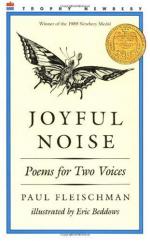
|
| Name: _________________________ | Period: ___________________ |
This test consists of 15 multiple choice questions and 5 short answer questions.
Multiple Choice Questions
1. How does the worker bee spend his days?
(a) Slaving away to provide for the hive.
(b) Flying around the hive looking for a mate.
(c) Eating bonbons and watching movies.
(d) Lounging around or laying eggs.
2. What are three words used to describe the whirligig beetle's movements?
(a) Zigzag, lightning, jagged.
(b) Merry-go-rounds, swerving, wheeling.
(c) Straight as a pencil, a line, sharp.
(d) Slow, languid, lazy.
3. For what else does the digger wasp prepare?
(a) Additions to its family.
(b) The coming of winter.
(c) Its death.
(d) A move to a new home.
4. Will the digger wasp ever see its offspring?
(a) Yes, for their entire lives.
(b) No.
(c) Yes, but only for a short while.
(d) Yes, for several weeks.
5. "Honeybees" is quite different from the previous poems. Why?
(a) The lives of all bees is not equal.
(b) The mood is not humorous.
(c) The bee is unhappy.
(d) There are two insects in this poem.
6. "The Digger Wasp" is told from whose perspective?
(a) A narrator.
(b) A young digger wasp.
(c) The adult digger wasp.
(d) Another insect.
7. Which bee believes life is relaxing and enjoyable?
(a) The bumble bee.
(b) The queen bee.
(c) The worker bee.
(d) The sweat bee.
8. This group of people slaved away for the small _____________ population who controlled the country.
(a) Poor.
(b) Unhealthy.
(c) Wealthy.
(d) Intelligent.
9. How does "Requiem" end?
(a) By giving the insects homes.
(b) By giving the cause of death.
(c) By blaming people for the deaths of these insects.
(d) By giving the names of the insects who have died.
10. Water boatmen are compared to whom?
(a) Dancers.
(b) Divers.
(c) Rowers.
(d) Skiers.
11. Why might the cause of death of these insects be surprising to humans?
(a) We do not often think about the importance of water.
(b) We do not often think about how important the spring thaw is.
(c) We do not often think about how important the hot sun is to nature.
(d) We do not often think about the importance of the first frost.
12. "Water Boatmen" frequently repeats what word?
(a) Swim.
(b) Stroke.
(c) Dive.
(d) Jump.
13. With what are the pages of the whirligig beetle's poem covered?
(a) Vocabulary describing this beetle.
(b) The word whirligig.
(c) Strong verbs describing these beetles.
(d) Drawings of these swerving, spinning beetles.
14. What does the digger wasp hope to do for its offspring?
(a) Make them jealous of it.
(b) Make them happy.
(c) Make life more exciting.
(d) Make life easier.
15. When read aloud by the two speakers, this poem creates a sense of what?
(a) Peace and quiet.
(b) Chaos and nervous energy.
(c) Anger and hostility.
(d) Happiness and contentedness.
Short Answer Questions
1. Upon contemplating this poem and the deaths of these insects, one becomes more aware of what?
2. What do the water boatmen and the digger wasp have in common?
3. The digger wasp feels _______________ that its offspring will understand the sacrifices it made for them.
4. What is the mood of "Water Boatmen?"
5. How does the queen spend her days?
|
This section contains 512 words (approx. 2 pages at 300 words per page) |

|




